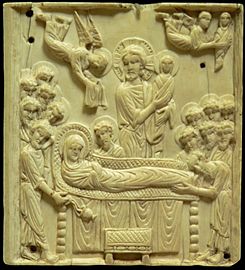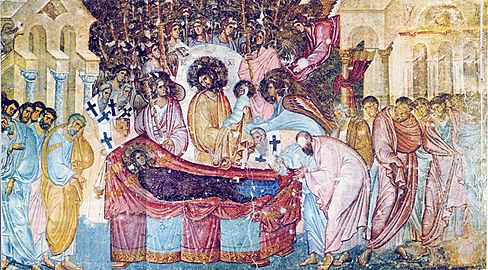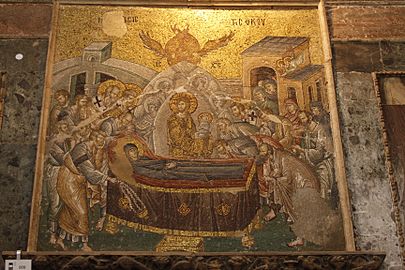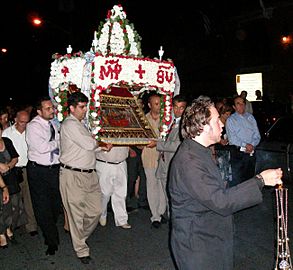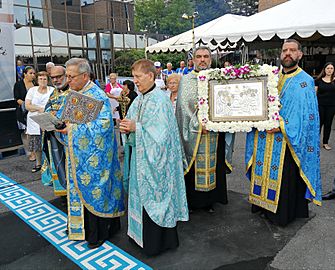Dormition of the Mother of God facts for kids
Quick facts for kids Dormition of the Mother of God |
|
|---|---|
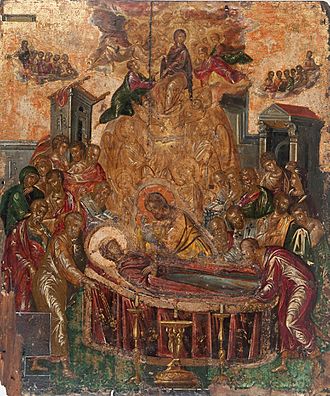
|
|
| Observed by | Eastern Christianity |
| Date | August 15 [O.S. August 28] |
| Frequency | annual |
The Dormition of the Mother of God is a very important celebration for Eastern Orthodox, Oriental Orthodox, and Eastern Catholic Churches. It celebrates the "falling asleep" (death) of Mary, the mother of Jesus. It also celebrates her body being taken up into heaven.
This special day is celebrated on August 15. Some churches that use an older calendar celebrate it on August 28. In Western Churches, this feast is often called the Assumption of Mary.
The Christian Bible does not talk about Mary's death. However, early Christian writers suggest that Mary lived for about 11 years after Jesus died. She passed away around the year AD 41.
The word dormition means "sleeping." It shows the belief that Mary died peacefully, without suffering. This idea comes from old Church traditions, not directly from the Bible. Both Orthodox and Roman Catholic Christians share this belief.
Contents
What is the Dormition Fast?
Before the Feast of the Dormition, there is a two-week fast. This fast is called the Dormition Fast. It lasts from August 1 to August 14.
During this time, Orthodox and Eastern Catholics avoid certain foods. They do not eat red meat, poultry, or dairy products. They also avoid fish, oil, and wine. If churches follow the old calendar, the fast is from August 14 to August 28.
The Dormition Fast is stricter than some other fasts. On weekends, only wine and oil are allowed, but not fish. There is one special day during the fast when fish, wine, and oil are allowed. This is the Transfiguration on August 6.
During the fast, some churches have special evening services. These services are similar to those held during Great Lent. Many churches also have a special outdoor procession on August 1. This day is also known as the Procession of the Cross.
What does "Dormition" mean?
In the language of the Bible, death is often called "sleeping" or "falling asleep." The Greek word for this is koimēsis. This is where the word "cemetery" comes from, which means "a place of sleeping."
The Latin word dormire also means "to sleep." This is why the feast is called "Dormition." Another example is the Dormition of Anna, who was Mary's mother.
How did this tradition start?
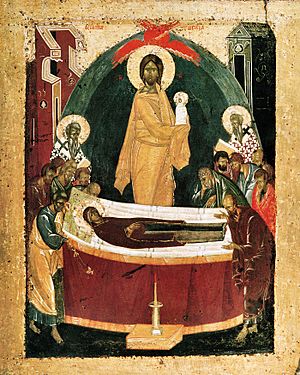
Traditions about Mary's "falling asleep" began very early. Some stories were told as early as the 3rd century. These stories were not part of the official Bible. However, they were important for how the Church understood Mary's life.
Some early writings suggest that the Dormition was celebrated as a holy day by the 4th century. The oldest known artwork showing the Dormition is from a church in Spain, dating back to around 330 AD.
Many Orthodox Christians believe that the Church has kept an oral tradition about Mary's death. This tradition goes back to the time of the apostles. The Gospels do not say when or how Mary died. But the Church's faith and the writings of early Christian leaders support this tradition.
Some early Church leaders, like Epiphanius of Salamis, wrote about Mary's death. He said that the Bible does not clearly state how Mary died. He believed that Mary's death was peaceful and pure. He also thought she might have been taken to heaven without seeing death, like the prophet Elijah.
The Story of the Dormition
Later traditions tell us more about Mary's final days. After Pentecost, Mary lived in Jerusalem with the Apostle John. The Archangel Gabriel told her that she would die in three days.
It is said that all the apostles, who were spread around the world, were brought together by a miracle to be with Mary when she died. The only one who was not there was Thomas, who was in India.
Thomas arrived three days after Mary's death. He saw her body being taken up to heaven. He asked her where she was going. Mary then gave him her girdle (a belt) as a gift. Then she disappeared.
Thomas then went to the other apostles. He asked to see Mary's grave to say goodbye. Mary had been buried in Gethsemane. When they opened the tomb, her body was gone. Only a sweet smell remained.
A vision then confirmed that Christ had taken Mary's body to heaven. This means her body was reunited with her soul. Eastern Orthodox Christians believe that Mary's body has already been resurrected. This is a special state that other good people will experience after the Last Judgment.
Important Places Related to the Dormition
The Dormition tradition is linked to several important places.
- Jerusalem: This city has Mary's Tomb and the Basilica of the Dormition.
- Ephesus: This city has the House of the Virgin Mary.
- Constantinople: This city once held the Cincture of the Theotokos, which was a belt believed to belong to Mary.
Dormition vs. Assumption
Eastern Christians celebrate the Dormition of the Theotokos on August 15. This is the same day that Roman Catholic Christians celebrate the Assumption of Mary.
"Dormition" and "Assumption" are different names for the end of Mary's life on Earth. Both beliefs agree that Mary was taken up into heaven with her body.
The Orthodox View
The Orthodox Church teaches that Mary died a natural death, just like any human. They believe that her soul went to Christ when she died. Then, on the third day after her death, her body was resurrected. At that time, she was taken up into heaven. The apostles found her tomb empty.
The Catholic View
The Catholic teaching of the Assumption says that Mary's body was taken to heaven. However, it does not say if she was alive or dead when this happened.
Many Catholics believe she died a normal death. Pope Pius XII spoke about her death several times. In 1950, he officially declared the Assumption of Mary a dogma (a core belief) of the Catholic Church.
In 1997, Pope John Paul II said that Mary experienced a natural death before she was taken to Heaven. He explained that Mary shared in Christ's suffering and death. He also said that Mary's passing from this life was a "full development of grace in glory." He called her death a "dormition" because it was so peaceful.
How is it celebrated in church?
Byzantine Rite
The Feast of the Dormition has a special period of preparation before it. It also has 8 days of celebration after it. This feast is part of three important feasts in August that honor Jesus Christ. These are the Procession of the Cross (August 1), the Transfiguration (August 6), and the Icon of Christ "Not Made by Hand" (August 16).
Burial Service of the Theotokos
In some places, a special service called the "Burial of the Theotokos" is held. This service is similar to the one for the burial of Christ on Great and Holy Saturday.
A special cloth icon, called an Epitaphios, is used. It shows Mary lying peacefully. Special hymns are sung with Psalm 118. This Epitaphios is carried in a procession, just like the one for Christ on Holy Saturday.
This tradition started in Jerusalem. From there, it spread to Russia. It is not done in all churches, but it is a very meaningful service where it is practiced.
Malankara Rite
The Malankara Orthodox Syrian Church also celebrates the Feast of Dormition on August 15. This day is also India's national independence day, so it is very important.
Maronite
The Maronite Church has a tradition about their special prayer, the Sharrar. They believe it was first used at Mary's funeral. This prayer has twelve parts, one for each apostle who was believed to be at Mary's funeral.
How is it shown in art?
Byzantine Art
In Byzantine art and later Orthodox art, the Dormition is shown in a specific way. Mary's body is shown lying on a bed. Behind her, Christ stands or floats. He holds a small figure wrapped in cloth. This figure represents Mary's soul. Christ often has a bright light around him.
The apostles stand around Mary's bed. Sometimes, angels, saints, and prophets are also shown in the sky. Christ is usually shown higher than the apostles. His feet are often hidden behind the bed, making it look like he is floating.
Some icons of the Dormition show Mary at the top of the icon. She is in a bright light, near the gates of heaven. This shows her being taken up to heaven.
Catholic Art
In Catholic art, the Dormition is known as the Death of the Virgin. It was a common subject until the end of the Middle Ages. Often, the art shows the moment just after Mary's death. The apostles are gathered around her bed.
The painting Death of the Virgin by Caravaggio (1606) is a famous example. After this time, paintings usually showed the Assumption. In these, Mary is shown alive, rising to Heaven.
Gallery
-
12th-century rendition of the Dormition by a Novgorod artist.
-
Uspenje presvete Bogorodice, a large fresco from 1265, Sopoćani Monastery, Serbia.
See also
 In Spanish: Tránsito de María para niños
In Spanish: Tránsito de María para niños



